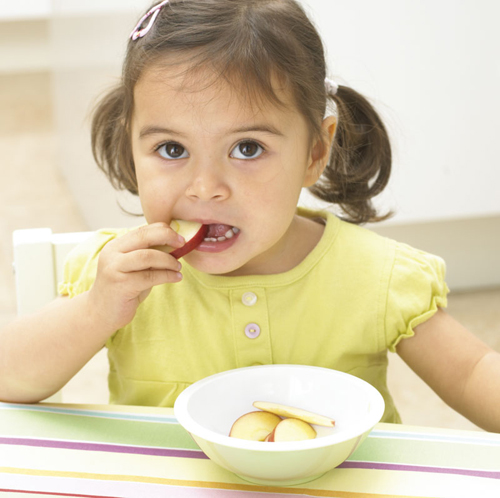A healthy diet is crucially important to your child’s health, development, growth, and well-being, and it is important to ensure that he is getting all the nutrients he needs in the form of healthy, regular meals. But healthy doesn’t mean boring! Tempt your child with fun, delicious meals.
| Q: |
What is the most important part of a child’s diet?
| | A: |
There is no single most important part, as every element combines
to produce the right balance of nutrients he needs to grow and develop,
and to achieve and maintain good health. Every child needs fats,
carbohydrates, protein, fiber, and vitamins and minerals, and all are
equally essential.
The key is balance
and variety. Balance simply means getting some of each food group in
every meal; vitamins and minerals are easily covered by including fresh
fruits and vegetables, and good-quality whole grains such as pulses and
whole wheat bread, brown rice, and pasta.
The second element is
variety. The greater the variety of foods you choose, the greater the
number of nutrients. So try thinking outside the box a little. Offer a
sweet potato rather than a traditional white potato, or some wheat pasta
in place of your normal white varieties. Choose brightly colored fruits
and vegetables, and mix and match them at each different meal. Offer
raw vegetables and a dip or a platter of fruit chunks as snacks. Grate
zucchini and carrots into sauces, and add pumpkin or sunflower seeds to
cookies or granola. If every meal is slightly different, you’ll be doing
a great job.
|
| Q: |
At what age should I start teaching my child about good nutrition?
| | A: |
It’s never too early to teach children about good nutrition. From
the earliest days, you can discuss various ingredients, and talk about
why they are good: fish makes your brain grow and makes you very clever;
berries make you strong and healthy with not so many colds and coughs;
oatmeal makes you super-energetic and you’ll be able to run around all
morning; cheese, milk, and yogurt make your bones and teeth strong …
that sort of thing.
Then use specific
examples to help drive the messages home. For example, if she’s tired
after a hyper high following a birthday party, explain that sugar makes
us super energetic for a while, but makes us tired and headachey later
on. It doesn’t mean lecturing kids, simply using every opportunity to
explain why good foods matters.
|
| Q: |
What are some good ideas for dips to go with raw fruits and vegetables?
| | A: |
Dips are a great way to encourage little ones to eat more fruit, and, in particular, vegetables.
Hummus, salad
dressings, and tzaziki are all good choices for raw vegetables, or try
stirring a teaspoon of pesto into a little plain yogurt or mayonnaise.
Even a tablespoon of ketchup mixed with the same amount of mayonnaise
makes a delightful pink dip that will appeal to little ones. Sour cream
or crème fraiche with chives is usually popular and will entice your
little one to pick up the veggies.
For fruit, honey, fruit
yogurt, fromage frais, or even a little maple syrup make tasty dips. One
of my favorite combinations for a tasty dip for fruit is 3 tbsp Greek
yogurt, 1 tsp milk, 1 tsp icing sugar, and 1 tsp lemon curd. Cinnamon
and apple purée or a good-quality store-bought fruit compôte added to
plain yogurt are delicious too.
|
| Q: |
I’ve heard that whole grains are best. What are some good ways to encourage my child to eat whole grains?
| | A: |
Whole grains, or foods made from them, contain all the essential
parts and naturally occurring nutrients of the entire grain. Whole
grains are not refined; nothing has been stripped or removed from the
grains. So whole wheat bread is a whole grain, while white bread is not.
They are rich in vitamins B and E, the minerals magnesium, selenium,
and zinc, fiber, and other valuable nutrients that have been shown to
protect against many health conditions, and encourage optimum health and
nutrition.
The question is
which grains, and how! Most little ones like corn, and it can be eaten
on its own or mixed into stews, soups, and even sandwich fillings. There
are some interesting whole-grain rices, such as red and wild rice
(which is, in fact, a grass) that can appeal to toddlers because they
are rather exotic looking. Stir a little barley into soups or
casseroles, use buckwheat or wheat pastas occasionally, and choose
whole-grain breads, such as whole wheat, oat, and millet for more
variety. Quinoa can be served rather like couscous, or stirred into
couscous or added to salads for extra crunch.
|
Did you know…
that raw fruits
and vegetables contain a powerful antioxidant called glutathione that
helps to detoxify your child’s body? It encourages healthy elimination
and sticks to the nasty bits in your child’s stomach, and then escorts
them out! New research also suggests that this antioxidant is crucial
for a healthy immune system. Just one more reason to offer fresh fruits
and vegetables to your little one throughout the day. Cut them into
bite-sized finger foods for a healthy snack.

|